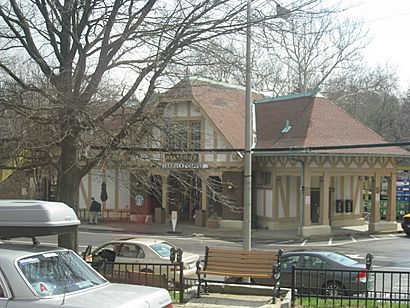Hartsdale station facts for kids
Quick facts for kids
Hartsdale
|
|||||||||||
|---|---|---|---|---|---|---|---|---|---|---|---|

Hartsdale station as seen from East Hartsdale Avenue
|
|||||||||||
| Location | 1 East Hartsdale Avenue, Hartsdale, New York | ||||||||||
| Line(s) | Harlem Line | ||||||||||
| Platforms | 2 side platforms | ||||||||||
| Tracks | 2 | ||||||||||
| Connections | Bee-Line Bus System: 34, 38, 39 | ||||||||||
| Construction | |||||||||||
| Parking | 797 spaces | ||||||||||
| Disabled access | Yes (to each platform); No (between platforms) |
||||||||||
| Other information | |||||||||||
| Fare zone | 4 | ||||||||||
| History | |||||||||||
| Opened | December 1, 1844 | ||||||||||
| Rebuilt | 1915 (NYC) | ||||||||||
| Electrified | 700V (DC) third rail | ||||||||||
| Previous names | Hart's Corner | ||||||||||
| Traffic | |||||||||||
| Passengers (2007) | 794,405 |
||||||||||
| Services | |||||||||||
|
|||||||||||
| Former services | |||||||||||
|
|||||||||||
|
Hartsdale Railroad Station
|
|||||||||||
| Location | Hartsdale, New York, USA | ||||||||||
| Architect | Warren and Wetmore | ||||||||||
| Architectural style | Tudor Revival | ||||||||||
| NRHP reference No. | 11000453 | ||||||||||
| Added to NRHP | July 14, 2011 | ||||||||||
The Hartsdale station is a train stop on the Metro-North Railroad's Harlem Line. It helps people travel to and from the areas of Greenburgh and Scarsdale, New York. This station is about 20.6 miles from Grand Central Terminal in New York City. A train ride usually takes between 33 and 48 minutes. This depends on if the train makes all stops or is an express. Hartsdale station is in Metro-North's Zone 4 for ticket fares.
Contents
A Look Back: Hartsdale Station's History
The first train station here was a small wooden building. It was built by the New York and Harlem Railroad. Back then, it was known as "Hart's Corner Station."
Building the Current Station
The station building you see today was built in 1915. Some records say it was built in 1914. It was designed by a famous architecture company called Warren and Wetmore. They built it for the New York Central Railroad. This new station replaced the older wooden one.
Warren and Wetmore often designed very grand train stations. Many of their buildings used a style called Beaux-Arts architecture. But the Hartsdale station was different. It was built in the Tudor Revival style. This style looks like old English country homes. The station got its name from the Hart family, who owned the valley.
Changes Over Time
In 1968, the New York Central Railroad joined with the Pennsylvania Railroad. This created a new company called Penn Central Railroad. So, Hartsdale became a Penn Central station.
However, Penn Central faced many money problems in the 1970s. Because of this, the Metropolitan Transportation Authority (MTA) took over their local train services. In 1983, these services became part of Metro-North Railroad.
In 2011, the Hartsdale station was added to the National Register of Historic Places. This means it's an important historical building.
How the Station is Set Up
The Hartsdale station has two platforms. These are called "side platforms." They are slightly offset, meaning one is a little ahead of the other. Each platform is long enough for 12 train cars. This station also has space for a third train track, even though only two are used now.
When you are at the station, you will find:
- A mezzanine level: This is like a bridge or walkway. It lets you cross safely between the two platforms.
- Platform level: This is where you wait for your train.
- Track 2: Trains heading south towards Grand Central Terminal use this track.
- Track 1: Trains heading north towards North White Plains use this track.
- Street level: This is where you can enter or exit the station. You'll also find parking and bus stops here.
Art at the Station
The Hartsdale station is home to some cool art. It's a series of sculptures called Workers. The artist is Tom Nussbaum. These sculptures show outlines of railroad workers and people riding the train.
The sculptures are made from a special kind of steel called COR-TEN® steel. This steel rusts in a way that creates a protective layer. You can see these sculptures between the tracks. There are also larger human figures made of iron placed near the tracks.



